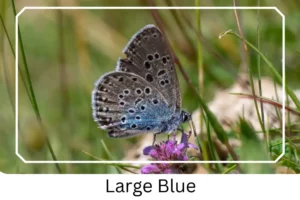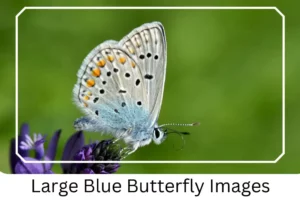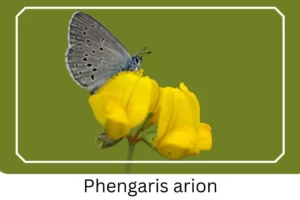Large Blue (Phengaris arion)
The Large Blue (Phengaris arion) butterfly, a member of the ‘blues’ family, boasts a name that might suggest a sizeable presence. However, it is, in fact, of medium size when compared to other butterflies. Its name serves to distinguish it from the smaller ‘Small Blue’ species, with which it shares a similar coloration pattern. Recognized as ‘Near Threatened’ by the IUCN 2.3, this species captivates with its unique life cycle and brilliant hues.
Scientific Classification
- Family: Lycaenidae
- Genus: Phengaris
- Scientific Name: Phengaris arion
Overview
The Large Blue butterfly exemplifies nature’s intricacy and the delicate balance of ecosystems. With a lifecycle that intertwines closely with specific flora and fauna, this species not only adds beauty to its habitat but also plays a role in the biodiversity of its environment. The presence of the Large Blue is a testament to the health of south-facing, unfertilized pastures it prefers, making its conservation a priority for ecological balance.
Description and Identification
Caterpillar
The journey of the Large Blue begins as a caterpillar, emerging at a mere 0.79 mm in length, adorned in pale ochreous-yellow tinged with green. Its body is marked by longitudinal rows of backward-curved, serrated hairs. The larva undergoes four instars, engaging in a fascinating parasitic relationship with the red ant species Myrmica sabuleti, before hibernating within the ant’s nest and eventually pupating.
Pupa
The chrysalis stage sees the Large Blue measuring about 12.7 mm, with a color transitioning from apricot-yellow to a darker amber, except over the wings. This phase is timed with the seasons, awaiting the warmth of spring for the emergence of the butterfly.
Adult Butterfly
Upon reaching adulthood, the Large Blue does not exhibit strong sexual dimorphism, making males and females relatively similar in appearance. The open wings reveal a vibrant blue with dark gray to blue spots resembling sesame seeds and gray borders. In contrast, the closed wings are predominantly grayish beige, adorned with black spots framed in bluish white. Females tend to be lighter in coloration than males.
Sexual Dimorphism: Not distinctly present
Color and Appearance: Bright blue open wings with gray-bordered forewings and similarly bordered hind wings. Closed wings show a stark absence of blue, displaying grayish beige with black spots.
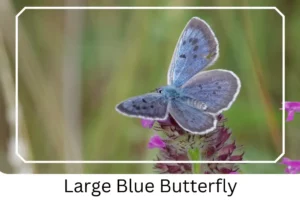
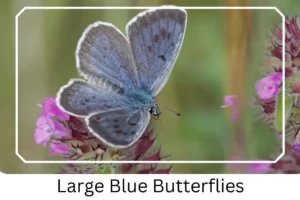 Average Wingspan: Up to 2 inches (50.8 mm)
Average Wingspan: Up to 2 inches (50.8 mm)
Flight Pattern: Generally average and even
Eggs
The eggs of the Large Blue are a sight to behold, very flat and semi-globular, with a pale bluish-white hue. These are delicately placed on the thymus of blooming buds, ensuring the next generation’s survival.
Quick Facts | |
| Distribution | Across Europe, excluding the extreme north and southern Spain |
| Habitat | Favors south-facing hillsides with close-cropped, unfertilized pasture |
| Lifespan of Adults | Lives for a few weeks |
| Host Plants | Thyme and wild marjoram oregano |
| Adult Diet | Feeds on flower nectar |
How to Identify Large Blue Butterfly?
Identifying the Large Blue butterfly involves observing several key characteristics. First, look for the vibrant blue coloration of the wings when open, a distinguishing feature among butterflies. The presence of sesame seed-shaped spots on the forewings and the unique gray borders of both pairs of wings are also indicative. When the wings are closed, the absence of blue, replaced by a grayish beige color with distinct black spots, is another identifying trait. Additionally, considering their preferred habitats, such as south-facing, unfertilized pastures, and their association with thyme and marjoram oregano plants, can also guide identification.
Did You Know?
- The Large Blue butterfly employs a remarkable strategy for survival by mimicking the chemical signals of the red ant Myrmica sabuleti, allowing it to live within the ant nest during its larval stage.
- This species was declared extinct in Britain in 1979 but was reintroduced successfully from continental Europe, showcasing the potential for conservation efforts to revive lost populations.
- The Large Blue’s reliance on specific ant species for its larval development highlights the intricate dependencies within ecosystems, underscoring the importance of biodiversity.
Conclusion
The Large Blue butterfly, with its mesmerizing colors and unique ecological role, stands as a symbol of nature’s complexity and the delicate interdependencies that sustain biodiversity. Its lifecycle, from the parasitic relationship with red ants to the careful selection of habitat and host plants, illustrates the intricate balance of ecosystems. Conservation efforts for the Large Blue not only help protect this fascinating species but also contribute to the broader goal of preserving biodiversity and ecological health. By understanding and appreciating the value of creatures like the Large Blue, we can take steps towards a more sustainable and interconnected world.

